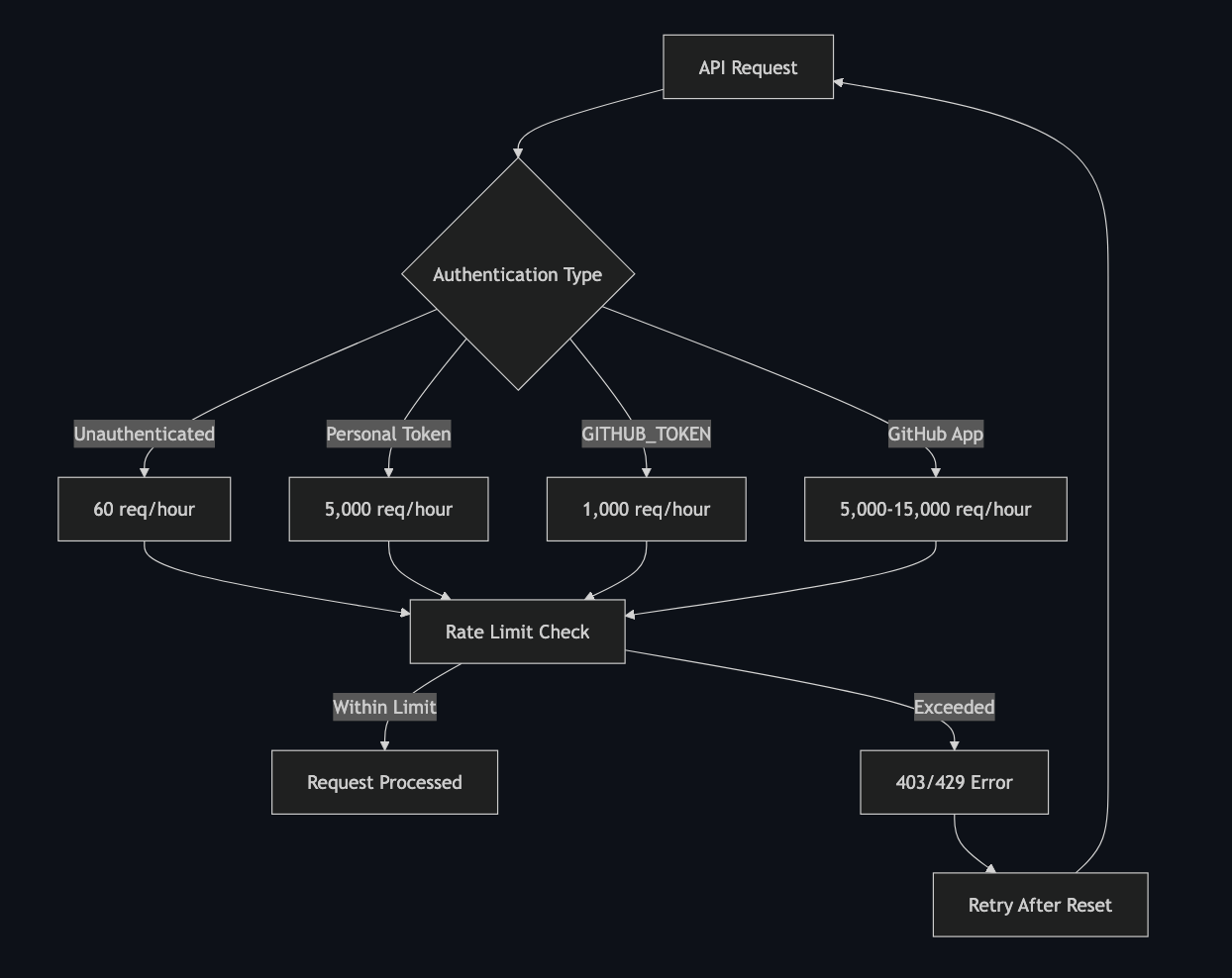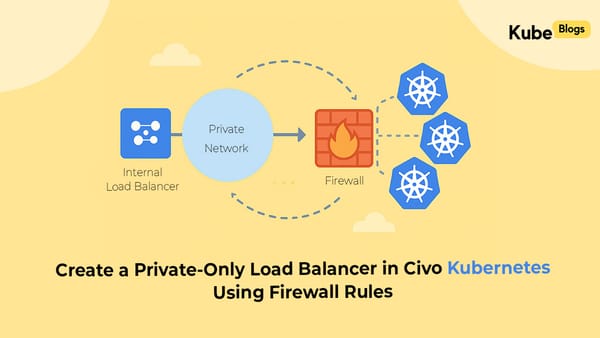Table of Contents
Introduction
GitHub API rate limits can break your CI/CD pipelines and automation workflows. When your GitHub Actions fail with 403 or 429 errors, it's usually because you've hit the rate limit ceiling. Understanding these limits and implementing proper strategies can save hours of debugging and prevent deployment failures.
GitHub enforces two types of rate limits: primary limits based on authentication method and secondary limits to prevent abuse. The most common issue teams face is the 1,000 requests per hour limit for GITHUB_TOKEN in GitHub Actions, which can be easily exceeded in active repositories with multiple workflows.
This guide covers practical strategies to avoid rate limiting, from token management to retry patterns, helping you build resilient automation that scales with your development velocity.
Understanding GitHub Rate Limits
GitHub uses different rate limits based on your authentication method:
- Unauthenticated requests: 60 requests/hour per IP
- Personal Access Tokens: 5,000 requests/hour
- GitHub Actions GITHUB_TOKEN: 1,000 requests/hour per repository
- GitHub Apps: 5,000-15,000 requests/hour (scales with repos/users)
Secondary limits include:
- Maximum 100 concurrent requests
- 900 points per minute for REST API endpoints
- 80 content-generating requests per minute

Token Management Strategies
Use GitHub Apps Instead of Personal Tokens
GitHub Apps provide higher rate limits and better security:
# .github/workflows/deploy.yml
name: Deploy with GitHub App
on:
push:
branches: [main]
jobs:
deploy:
runs-on: ubuntu-latest
steps:
- name: Checkout
uses: actions/checkout@v4
with:
token: ${{ secrets.GITHUB_APP_TOKEN }}
- name: Deploy
run: |
# Your deployment logic hereImplement Token Rotation
Rotate tokens regularly to avoid hitting limits:
#!/bin/bash
# token-rotation.sh
OLD_TOKEN=$1
NEW_TOKEN=$2
# Update secrets in repository
gh secret set GITHUB_TOKEN --body "$NEW_TOKEN"Use Repository-Specific Tokens
Create separate tokens for different repositories to distribute the load:
# Different tokens for different purposes
env:
DEPLOY_TOKEN: ${{ secrets.DEPLOY_TOKEN }}
NOTIFY_TOKEN: ${{ secrets.NOTIFY_TOKEN }}
BACKUP_TOKEN: ${{ secrets.BACKUP_TOKEN }}Rate Limit Handling in Code
Implement Exponential Backoff
import time
import random
from functools import wraps
def retry_with_backoff(max_retries=3, base_delay=1):
def decorator(func):
@wraps(func)
def wrapper(*args, **kwargs):
for attempt in range(max_retries):
try:
return func(*args, **kwargs)
except Exception as e:
if "rate limit" in str(e).lower() and attempt < max_retries - 1:
delay = base_delay * (2 ** attempt) + random.uniform(0, 1)
time.sleep(delay)
continue
raise
return None
return wrapper
return decorator
@retry_with_backoff(max_retries=5, base_delay=2)
def make_github_request(url, headers):
response = requests.get(url, headers=headers)
if response.status_code == 429:
retry_after = int(response.headers.get('Retry-After', 60))
time.sleep(retry_after)
raise Exception("Rate limited")
return responseCheck Rate Limit Headers
Always monitor rate limit headers in your requests:
def check_rate_limit(response):
remaining = int(response.headers.get('X-RateLimit-Remaining', 0))
reset_time = int(response.headers.get('X-RateLimit-Reset', 0))
if remaining < 100: # Warning threshold
print(f"Warning: Only {remaining} requests remaining")
print(f"Rate limit resets at: {reset_time}")
return remaining, reset_timeCI/CD Pipeline Optimization
Batch API Requests
Combine multiple operations into single requests:
# Instead of multiple individual requests
- name: Get PR details
run: |
# Bad: Multiple API calls
gh pr view ${{ github.event.pull_request.number }} --json title
gh pr view ${{ github.event.pull_request.number }} --json body
gh pr view ${{ github.event.pull_request.number }} --json files
# Good: Single API call
gh pr view ${{ github.event.pull_request.number }} --json title,body,filesCache API Responses
Use GitHub Actions cache to reduce API calls:
- name: Cache API response
uses: actions/cache@v3
with:
path: ~/.cache/github-api
key: ${{ runner.os }}-api-cache-${{ github.sha }}
restore-keys: |
${{ runner.os }}-api-cache-
- name: Use cached data
run: |
if [ -f ~/.cache/github-api/data.json ]; then
echo "Using cached data"
else
echo "Fetching fresh data"
gh api repos/${{ github.repository }}/commits > ~/.cache/github-api/data.json
fiOptimize Workflow Triggers
Reduce unnecessary workflow runs:
# Only run on specific paths
on:
push:
branches: [main]
paths:
- 'src/**'
- 'package.json'
- '.github/workflows/**'
# Skip workflows for draft PRs
- name: Skip for draft PRs
if: github.event.pull_request.draft == true
run: exit 0Monitoring and Alerting
Set Up Rate Limit Monitoring
- name: Monitor rate limits
run: |
response=$(gh api rate_limit)
remaining=$(echo $response | jq '.rate.remaining')
if [ $remaining -lt 100 ]; then
echo "::warning::Rate limit low: $remaining requests remaining"
fiCreate Rate Limit Dashboard
import requests
import json
from datetime import datetime
def monitor_rate_limits(token):
headers = {'Authorization': f'token {token}'}
response = requests.get('https://api.github.com/rate_limit', headers=headers)
data = response.json()
rate = data['rate']
print(f"Remaining: {rate['remaining']}")
print(f"Reset time: {datetime.fromtimestamp(rate['reset'])}")
if rate['remaining'] < 100:
# Send alert to Slack/Teams
send_alert(f"GitHub rate limit low: {rate['remaining']} remaining")Best Practices Summary
- Use GitHub Apps for higher rate limits and better security
- Implement exponential backoff in all API calls
- Monitor rate limit headers in your applications
- Cache API responses to reduce redundant requests
- Batch multiple operations into single API calls
- Optimize workflow triggers to avoid unnecessary runs
- Set up monitoring to get early warnings
- Rotate tokens regularly to distribute load
Conclusion
GitHub rate limiting is a common issue that can break your automation, but it's entirely avoidable with proper planning. The key is understanding your usage patterns and implementing the right strategies from the start.
Focus on using GitHub Apps for higher limits, implementing proper retry logic, and monitoring your usage. These simple changes can prevent hours of debugging and keep your CI/CD pipelines running smoothly.
Remember: rate limits exist to keep the API stable for everyone. By following these practices, you're not just avoiding limits—you're building more resilient and efficient automation.






